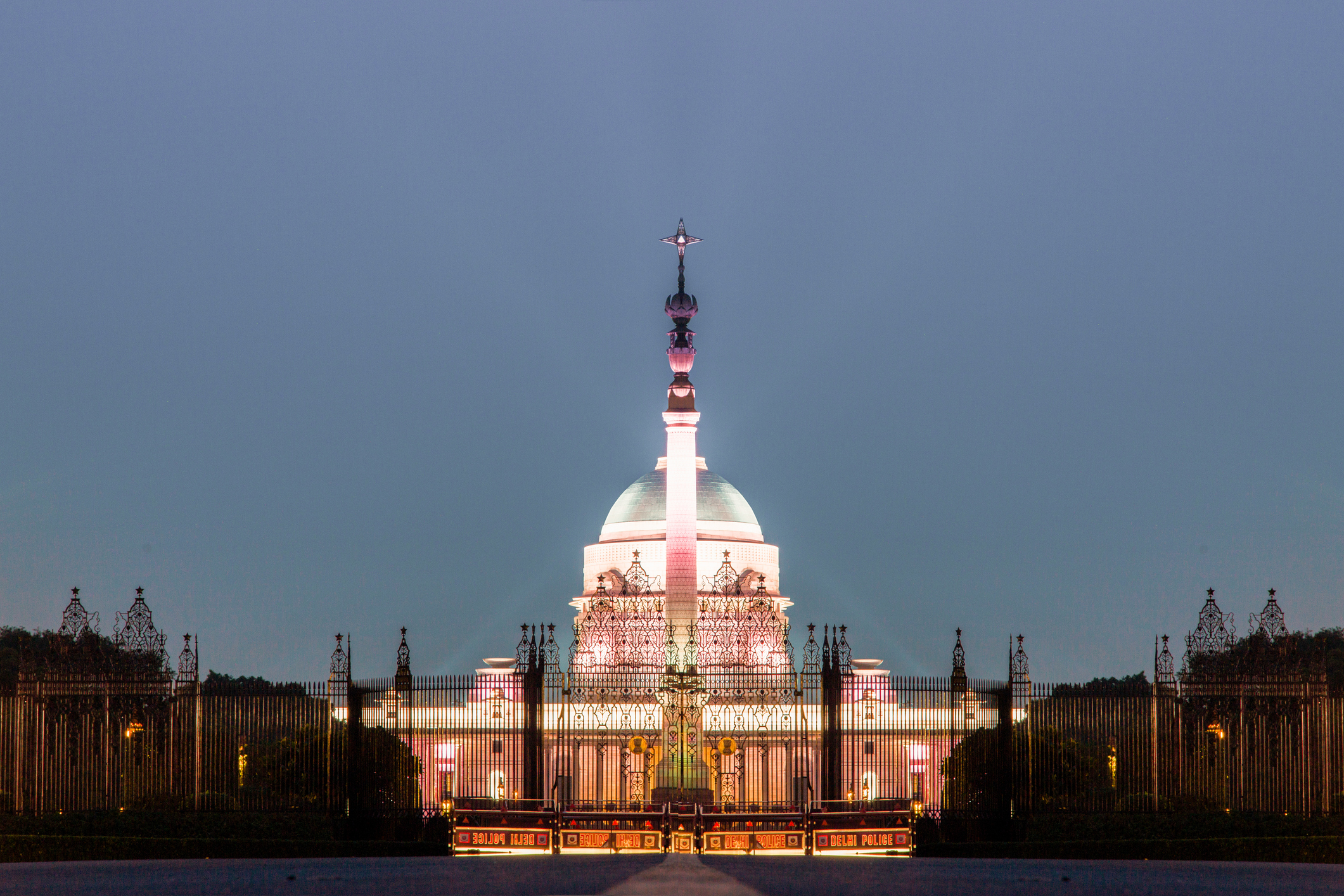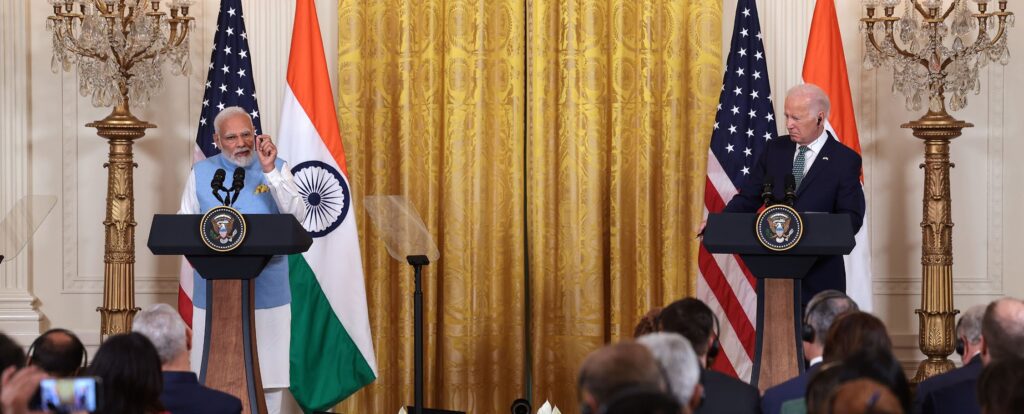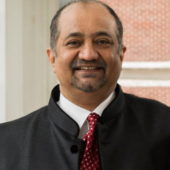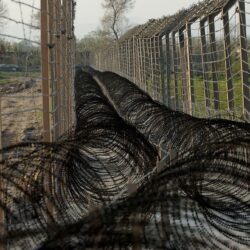
Since the turn of the century, the chatter about India as an emerging global power has become louder and louder. The drivers of this perception are the steady growth in India’s defense budget; the recognition of the talent of its engineers, doctors, scientists and managers; the success of the Indian diaspora; and India’s rapid GDP growth. The fact that India is a democracy also adds to its international appeal. Western nations saw very early on that India was not only a natural ally of the West because of its democratic ethos but was also a preferred rival to China, where authoritarianism remains entrenched. This geostrategic difference adds to India’s importance. The U.S., India’s biggest trading partner, sees U.S.-India relations as the “most consequential relationship of this century.” [1] And U.S. officials now routinely parrot the refrain that India, the world’s biggest democracy, and the U.S., the world’s oldest democracy, are natural allies and partners in advancing a global order that defends democracy and the rule of law. [2]
Since the George W. Bush administration, the U.S. has been facilitating the rise of India, as it enabled the rise of China in the 1990s. The sanctions imposed on India for testing nuclear weapons were eased and efforts have since been made to groom India as a potential partner in containing the rise of China as a challenger to U.S. hegemony and to the liberal international order. India is eager to gain a permanent seat on the U.N. Security Council. It feels that this achievement will not only underscore India’s status as a major power but also give it the protection it seeks from international criticism as it pursues its ideological goals in the domestic arena. India has witnessed how the U.S. has used its power at the U.N. not only to advance its own interests but also to safeguard the interests of its allies. From the day it gained independence, India has felt that it was destined to be a great power and will one day achieve its “rightful place” on the global stage. Becoming part of the global governing elite, meaning a permanent member of the U.N. Security Council, and having more say in the management of multilateral institutions like the World Bank and the International Monetary Fund, would be the pathway to this “rightful place.” This idea was born with the concept of a modern, independent India. In his famous speech “Tryst With Destiny,” delivered on the eve of India’s independence, India’s first prime minister, Jawaharlal Nehru, pledged that he would work “to the end that this ancient land attain her rightful place in the world and make her full and willing contribution to the promotion of world peace and the welfare of mankind.” [3]
India’s Hunger for Global Status
The Indian foreign policy elite is desperate for international validation of India as an important nation on the global stage. Often, to satiate that hunger, fake news about international recognition is circulated in Indian media that makes India look more powerful and influential than it is. For example, there were fake reports circulated in mainstream Indian media that Prime Minister Narendra Modi had been nominated for a Nobel Peace Prize. The media frenzy around this fake report subsided only after a member of the Norwegian Nobel Committee issued a statement denying the nomination. [4] Surveys by inconsequential private consultants that show Modi to be the most popular global leader make headlines and are mentioned frequently by talking heads and government officials, but those same individuals challenge or vehemently reject international indices that show India performing poorly on the happiness index, the hunger index, or human rights and democracy measures. Every critical report about India’s human rights record is labeled as biased and fake, even though those reports are well documented in the U.S. State Department’s 2022 report. The present Indian leadership, politically engaged population, and media, it is safe to say, are seeking international recognition more intensely than their counterparts in any other nation in the world today.
This hunger is driven by frequent developments that indicate India’s rise. The recognition by the IMF that India is the fastest growing major economy in the post-COVID-19 era and the fact that it has now surpassed the United Kingdom as the fifth largest economy in the world are clear indicators that India is gaining in the economic sphere. India has recently become the world’s most populous country, and this too is seen as a marker of India’s achievement. The year 2023 has become a diplomatic bonanza for India. India became the host and president of two important multilateral forums, the G20 and the Shanghai Cooperation Organization. This has kept India in the global diplomatic limelight for most of the year, during which time it has sought to set the global agenda and establish itself as an important global power and the voice of the Global South. Even invitations for state visits for Modi by the U.S. and France reenforce the perception that India is the new “golden boy” of international relations.
Additional markers of India’s global influence include the success of India’s diaspora in business (think tech CEOs) and in politics (think Rishi Sunak and Kamala Harris); the emergence of powerful business houses like the Ambanis, Adanis, and Tatas; and the growing political influence of Indian Americans. The India story can be seen in everything from the emergence of India’s growing middle class as a major market to the recognition of the global importance of India’s IT, and from the diamond and pharmaceutical industries to India’s growing defense imports.
India’s successes have not happened by accident. The country has made major investments in digital access, and today Indians on the internet outnumber Chinese and Americans combined. The Indian government is also investing in national infrastructure, building more roads, airports, metros, and bullet trains, which is contributing to the rapid development and economic growth of the nation. According to UNICEF, in the decade 2010-2020, India lifted 271 million people out of poverty. Additionally, India’s exports have also increased, and the country is likely to see its exports surpass $1 trillion U.S. in the year 2023. India has also benefited from the Russia-Ukraine war and has imported Russian oil at discounted prices; it now exports refined oil to Europe and North America. Both public sector and private sector oil companies have made huge profits from this unexpected opportunity.

U.S. President Joe Biden (R) and Indian Prime Minister Narendra Modi hold a joint press conference at the White House on June 22, 2023. (Win McNamee / Getty Images)
Besides all these economic and diplomatic achievements, the key reason all eyes are now on India is the persistent wooing of India by the Biden administration. U.S. officials have not only increased both the frequency and the intensity of their engagement with Indian counterparts, the U.S. has also signed many defense agreements, increased cooperation in the arena of critical emerging technologies and intelligence sharing, and is committed to upgrading India’s defense capabilities. The sale and transfer of F414 jet engines, which will be made in India by Hindustan Aeronautics, is the latest development in the U.S.-India defense partnership. This is a game-changer for India’s air strike capability, as well as its defense industry. Finally, the state dinner President Joe Biden hosted for Modi on June 22, 2023, and Modi’s address to a joint session of Congress have gone a long way toward sending a message to the world – especially to India and China – that U.S.-India relations have now reached unprecedented heights and that India is important to the U.S. Everybody now knows that India is one of the cool kids on the global campus.
The Dark Side of the India Story
But there is another side to the India story – a much darker side. This is a story that is rarely told in mainstream Indian media, but the global media is more committed to telling both sides of the India story. The other side is about two critical issues: one, the rise of Hindu nationalism and its terrible impact on democracy and the rights of religious minorities in India, especially Indian Muslims; and two, the structural flaws in India’s economic growth that are hidden by an unusually high focus on GDP growth alone as a measure of economic development.
In his book “India is Broken,” Princeton professor Ashoka Mody, a former IMF economist, identifies three major flaws in the Indian economy. He argues that the economy is growing but without generating jobs, and hence the unemployment rate in India is very high for a country whose economy is growing at over 6%. The unemployment rate in mid-July 2023 was 8.4%, according to the Center for Monitoring Indian Economy. [5]
Mody also argues that India is suffering from chronic underemployment. Many rural workers’ employment is seasonal, yet those workers are considered employed for purposes of tracking unemployment. Many people with advanced degrees are not working in their fields, but rather working as drivers for home delivery of food and goods, or as drivers for ride-hailing services. Such realities are hiding the extent of India’s unemployment. The most shocking aspect of India’s economy is the decline in women’s labor force participation, which dropped from 30% in 1990 to 19% in 2021 and is around 23% at the moment. [6] Mody also argues that India’s economic growth is insensitive to the damage it is causing the environment, and hence is not as sustainable as the government claims. He also finds the quality of India’s rapidly expanding private education institutions less than desirable. He feels that if India does not improve the quality of its education, it will fall behind other Asian nations that invest more in their human resources. [7]
As for India’s democratic backsliding, the U.S. State Department and the U.S. Commission on International Religious Freedom have systematically documented the many ways in which minorities in India are persecuted. Democracy indices have, especially since 2019 (the beginning of Modi’s second term), downgraded India to the status of a flawed democracy. The Swedish think tank V-Dem labeled India an “electoral autocracy,” and Freedom House has also highlighted the decline of freedom under the rule of Modi. [8] The State Department’s 2022 annual report is damning: It meticulously documents the persecution of religious minorities, especially Muslims, in India under Modi and his Hindu nationalist party (Bharatiya Janta Party). The atrocities documented include mob lynching of Muslims, extrajudicial bulldozing of Muslims’ homes and places of worship, violence against Muslims by mobs as well as police, passage of laws that violate religious freedoms, and frequent calls for genocide of Indian Muslims and hate speech by Hindu priests and Hindu nationalist political leaders. [9]
The two sides of the India story were dramatically on display when Modi visited the U.S. in June 2023. While the White House and the U.S. Congress laid out the red carpet for Modi, and Biden spoke eloquently of India’s democratic DNA, over 75 U.S. senators and representatives wrote a letter to Biden demanding that he raise the issue of India’s terrible human rights records directly with Modi. [10] Many of them also chose to boycott Modi’s address to Congress. While Biden was bending backward not to ruffle India’s feathers, former President Barack Obama said in an interview with journalist Christiane Amanpour that the “protection of the Muslim minority in a majority-Hindu India” was “something worth mentioning” during the state visit. He added, “If you do not protect the rights of ethnic minorities in India, then there is a strong possibility India at some point starts pulling apart.” There are some who believe that Obama may have made this comment at Biden’s behest to send the message to India that the U.S. was not overlooking the democratic backsliding of India. [11] These comments sparked backlash from Indian leaders, who attacked Obama for being hypocritical since he had bombed several Muslim countries during his time as president. The most shocking reaction came from a senior leader of Modi’s party, Himanta Biswa Sarma, the chief minister of the state of Assam, who told a journalist that there were many Hussain Obamas in India and that Assam police would prioritize “taking care of them,” then head to Washington, D.C. Ironically, while India’s prime minister was talking about how there was no room for discrimination in India, his own party member was threatening Muslim minorities with police for no reason. The man has faced no consequences for his blatant bigotry. [12]
Clearly there are two sides to the India story: one about India’s emergence as a major economic and global power, and the other about its steady transformation into an electoral autocracy that treats its religious minorities terribly. In the two months prior to this writing, overlapping with Modi’s visit to the U.S., over 250 churches have been burned down in the state of Manipur, which is also ruled by Modi’s Hindu nationalist party (BJP). The state is experiencing an ethnic and religious civil war in which over 140 people have been killed and thousands displaced and rendered homeless. [13] The European Parliament passed an urgency resolution on the violence in Manipur hours before Modi landed in Paris to be a state guest at France’s Bastille Day celebrations. [14] Unless India seriously addresses its domestic religious polarization and targeting of minorities, it will be hard even for the Biden administration, which is comfortable working with illiberal leaders all over the world, to keep India in the camp of democracies. India is on its way to becoming a more developed, more powerful, and more influential country, but it is also suffering from a serious domestic crisis that could undermine progress. It can and probably will emerge as a major power, but first it must address the communal hatred that unfortunately is becoming more lethal and more widespread around the country.
Brief Summaries of the Book Chapters
For this anthology, titled “Rise of India as a World Power,” the New Lines Institute for Strategy and Policy has invited an extraordinary group of scholars, experts, and practitioners to contribute their views. The essays, like the diverse contributors, bring a variety of perspectives that paint a multifaceted picture of India’s rise and the challenges it faces. In the first essay, professor Sumit Ganguly, a prominent scholar of Indian foreign policy and South Asian politics, argues that India can emerge as a global power, but it must make significant changes in its posture toward the U.S. and its defense procurement policies, end its geopolitical rivalry with Pakistan, and address the persistent poverty in the nation. While he acknowledges that many authoritarian nations have become great powers, he feels that India’s lurch toward authoritarianism could become a major impediment to its march toward great power status. Ganguly argues that India’s democracy, albeit flawed, has succeeded in managing the country’s vast diversity, but if India retreats from its democratic principles, then it will jeopardize its domestic and social order.
Ambassador Talmiz Ahmad, who has served as India’s ambassador to many Middle Eastern countries, is intimately aware of both the process and content of Indian foreign policy. He argues that Modi has worked hard to improve relations with Middle Eastern countries, and has been successful, but worries that India’s reputation as well as its long-term interests are not being served well by the Hindutva ideology that informs the Modi government. He also points to weaknesses in the Indian economy and predicts that it will not reach the target of $5 trillion U.S. by 2025, as predicted by the Modi government. [15] Ahmad also laments the loss of opportunity. The U.S. has slowly retreated from the Middle East, and India, which has good business relations with the nations in the region, has not enhanced its strategic role. It has allowed China to step into the vacuum created by the U.S. pivot away from the Middle East. He predicts that constrained by Hindutva values, which target Muslims at home, India can only maintain transactional and business relations with the Middle East, and shared strategic goals and actions will be limited.
Michael Kugelman, director of the South Asia Institute at the Wilson Center, argues that while Pakistan is capable of putting hurdles in India’s path, it cannot at the moment prevent India’s rise. A combination of the widening gap between India and Pakistan’s capabilities along with domestic political and economic instability have diminished Pakistan’s ability to curtail the rise of India and its growing international profile. Kugelman also points out that while Pakistan does possess assets that allow it to pose asymmetric threats to India, it has for the moment reduced such activity. Additionally, Pakistan’s fortunes in Afghanistan have not fared well, and hence Pakistan will continue to maintain peace and calm on its eastern border with India while dealing with the challenges it faces from Afghanistan on its western border. Kugelman sees challenges to India’s emergence as a world power coming more from India’s other neighbor, China, a more powerful and more aggressive power.
Aparna Pande is a research fellow at the Hudson Institute, and her work focuses on India’s foreign policy and the politics and geopolitics of South Asia. Pande draws an intriguing portrait of India as an aspiring world power, but a “different kind of world power.” She argues that India is seeking recognition as a global power with a moral identity – Vishwaguru (world teacher). The country does not have hegemonic aspirations in the region or globally. It does not have any territorial aspirations, nor does it seek to upset the existing order. According to Pande, this “Indian exceptionalism” is based on a form of nationalism that takes pride in its civilizational heritage and is neither territorial nor ideological. In her essay, Pande also emphasizes the importance of the emerging and rapidly growing India-U.S. alliance.
Ghazala Wahab, a defense expert who also edits and publishes FORCE, a monthly journal on security issues, has contributed a counterintuitive and persuasive challenge to the narrative that India is a rising military power. She points out that India’s status as having the third largest defense budget in the world and also being the third or fourth largest importer of military equipment is being confused with military power. She argues that while India is indeed spending more than most nations on military power, it is not deterring other nations such as Pakistan and China from pursuing their aggressive cross-border attacks and violations. For Wahab, deterrence is the measure of power. Wahab also dispels the myth of the policy/goal of Atmanirbhar (self-reliance) in the defense sector. She observes that the resources earmarked for research and development are very low, and almost all major weapons manufacturing in India happens through collaboration with foreign firms. Wahab suggests that heralding India as a major military power is premature, and that it will be a while before India actually becomes self-reliant and successfully deters its enemies.
India seeks greater responsibility and recognition on the global stage, and as part of this pursuit it has persevered in pushing for reforms first of the U.N. Security Council and now of the entire system of multilateral governance. Retired Ambassador Syed Akbaruddin, who has served as India’s permanent representative to the U.N., recounts in detail how India has sought reform of the U.N. Security Council to make it more representative and more in alignment with current realities, and to attain a permanent membership. He explains how India’s strategy for reform has evolved and how various international stakeholders have ensured that the process is consistently stymied, and no reforms have taken place. India’s failure to achieve a permanent seat at the U.N. Security Council reveals the nature of global politics: Institutional continuity prevails despite major shifts in economic and military balances of power.
[1] See comments by Rich Verma, the deputy undersecretary of state, as reported by Financial Express, April 27, 2023. https://www.financialexpress.com/business/defence-india-us-relationship-the-most-consequential-relationship-of-this-century-top-us-diplomat-3064684/. Similar observations are regularly repeated by senior diplomats.
[2] Pande, A. (2020). Making India great: The promise of a reluctant global power. HarperCollins; Jaishankar, S. (2020). The India way: Strategies for an uncertain world. New Delhi.
[3] See the full text of Nehru’s speech at: https://thewire.in/history/india-at-75-jawaharlal-nehru-tryst-with-destiny-full-text
[4] See media reports fact-checking this fake news: https://www.business-standard.com/article/current-affairs/fact-check-did-asle-toje-call-pm-modi-biggest-contender-for-nobel-prize-123031600463_1.html
[5] Centre for Monitoring Indian Economy Pvt. Ltd. (n.d.) CMIE statistics. Retrieved July 21, 2023, from https://www.cmie.com/kommon/bin/sr.php?kall=warticle&dt=20230501182648&msec=936
[6] S, V. (2023, March 19). MPW 2022: India’s female labour force is plunging; can country’s growing economy afford this? Business Today. https://www.businesstoday.in/magazine/deep-dive/story/mpw-2022-indias-female-labour-force-is-plunging-can-countrys-growing-economy-afford-this-372141-2023-03-03
[7] Mody, A. (2023). India Is Broken: A People Betrayed, Independence to Today. Stanford University Press. See also the author’s “Khanversation” with Mody about his book on YouTube at: https://youtu.be/7sLBuc90_ec.
[8] Biswas, S. (2021, March 16). ‘Electoral autocracy’: The downgrading of India’s democracy. BBC News. https://www.bbc.com/news/world-asia-india-56393944
[9] See the State Department’s report on the state of religious freedom in India: https://www.state.gov/reports/2022-report-on-international-religious-freedom/india/. Also see the U.S. Commission on International Religious Freedom’s report: https://www.uscirf.gov/sites/default/files/2023-05/India%202023.pdf.
[10] Rai, S. (2023, June 20). Democrats push Biden to make human rights a focus in meeting with Modi. The Hill. https://thehill.com/policy/international/4058441-democrats-human-rights-modi-biden-visit/
[11] HT News Desk. (2023, June 23). Obama’s comments on Modi coincidental? Congress MP says ‘would be surprised if …’. The Hindustan Times. https://www.hindustantimes.com/india-news/obamas-comments-on-modi-coincidental-congress-mp-says-would-be-surprised-if-101687486315221.html
[12] The Wire Staff. (2023, June 23). ‘Hussain Obama’: Assam CM Himanta targets, threatens US ex-prez with Islamophobic slur. The Wire. https://thewire.in/communalism/hussain-obama-himanta-biswa-sarma
[13] See report in The Guardian on the state of affairs in Manipur: https://www.theguardian.com/world/2023/jul/10/foreigners-on-our-own-land-ethnic-clashes-threaten-to-push-indias-manipur-state-into-civil-war. The Telegraph reports that 253 churches have been burnt in Manipur. See https://www.telegraphindia.com/north-east/253-churches-burnt-down-during-continuing-unrest-in-manipur-indigenous-tribal-leaders-forum/cid/1944597.
[14] European Parliament. (2023, July 12). Joint motion for a resolution on India, the situation in Manipur (2023/2781[RSP]). https://www.europarl.europa.eu/doceo/document/RC-9-2023-0335_EN.html
[15] PIB Delhi. (2022, Nov. 12). No one can stop the Indian economy from holding the 3rd rank in the world by 2027- Amit Shah. Ministry of Home Affairs. https://www.pib.gov.in/PressReleasePage.aspx?PRID=1875480





